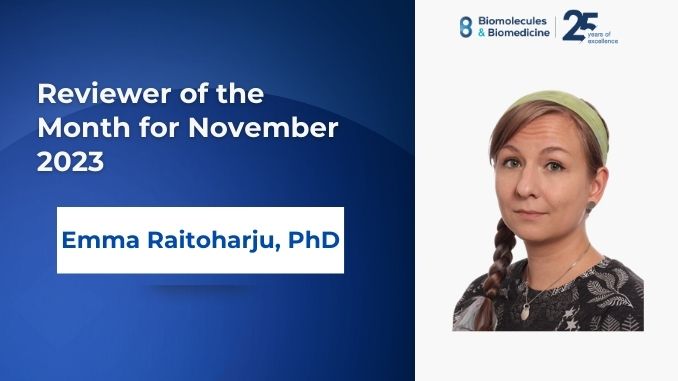
Peer review is an essential part of the scientific publishing process, helping to ensure that research papers meet high standards of quality and accuracy. Each month, the BiomolBiomed Editorial team recognizes a reviewer who has gone above and beyond in providing thoughtful and constructive feedback on the manuscripts they’ve reviewed.
This month, we’re pleased to announce that the Reviewer of the Month Award goes to Emma Raitoharju, PhD, from the Department of Clinical Chemistry, Tampere University Hospital and the Medical School at the University of Tampere, Tampere, Finland. Dr. Raitoharju’s review stood out for its exceptional quality, providing authors with valuable feedback that helped them improve the clarity and rigor of their research.
We sat down with Dr. Raitoharju to learn more about her approach to peer review and her thoughts on the current state of the publishing industry. Here are a few highlights from our conversation:
Please tell us more about your research interests and share your thoughts on recent advances or current issues that are currently shaping your field.
I have broad research interests in the field of molecular epidemiology, but lately, I’ve been primarily focused on the associations between epigenetic profiles and the development of cardiovascular diseases. In the swiftly evolving field of epigenetics, I am particularly excited about the growing body of information on the dynamics of human DNA methylation patterns and the functions of unique regions in our genome, such as imprinted genes.
How has the peer-review process evolved over the years, and where do you see it going in the future? How do you ensure that you remain impartial and objective in your reviews?
The number of journals and submissions has greatly increased. As a reviewer, I encounter many data-based manuscripts. While the biostatistical methods and results can be impressive, often the understanding of molecular biology and the conclusions drawn are lacking. I believe that with open data, advancements in bioinformatics and AI, the influx of such submissions will only grow. It will be a challenging task for editors and reviewers to ensure that scientific publications offer more than just a list of results.
In today’s rapidly evolving scientific landscape, what are some of the emerging trends or best practices you have observed in the field of scientific publishing?
In my field, I’ve truly appreciated the benefits of open data and collaboration, seeing firsthand how replicating results refines and validates scientific findings.
We’re thrilled to honor Dr. Raitoharju as our Reviewer of the Month and we’re grateful for her contributions to the scientific community. We hope that her example will inspire other reviewers to strive for excellence in their work and will encourage everyone to value the peer review process as an essential part of the scientific publishing ecosystem.
The translation of the preceding English text in Finnish:
Vertaisarviointi on olennainen osa tieteellistä julkaisuprosessia, auttaen varmistamaan, että tutkimusartikkelit täyttävät korkeat laatu- ja tarkkuusstandardit. Joka kuukausi BiomolBiomed-toimitustiimi tunnustaa arvioijan, joka on mennyt pidemmälle tarjotessaan harkittua ja rakentavaa palautetta käsikirjoituksista, joita he ovat arvioineet.
Tämä kuukausi on ilo ilmoittaa, että Kuukauden arvioija -palkinto menee Emma Raitoharjulle, tohtori, Kliinisen kemian osastolta, Tampereen yliopistosairaala ja Lääketieteellinen tiedekunta Tampereen yliopistossa, Tampere, Suomi. Tohtori Raitoharjun arvio erottui sen poikkeuksellisesta laadusta, tarjoten tekijöille arvokasta palautetta, joka auttoi heitä parantamaan tutkimuksensa selkeyttä ja perusteellisuutta.
Istuimme alas tohtori Raitoharjun kanssa oppiaksemme lisää hänen lähestymistavastaan vertaisarviointiin ja ajatuksistaan nykyisen julkaisualan tilasta. Tässä on muutama kohokohta keskustelustamme:
Kerro lisää tutkimuskiinnostuksistasi ja jaa ajatuksesi viimeaikaisista edistysaskeleista tai nykyisistä kysymyksistä, jotka muokkaavat alaasi.
Minulla on laajat tutkimuskiinnostuksen kohteet molekyyli-epidemiologian alalla, mutta viime aikoina olen keskittynyt pääasiassa epigeneettisten profiilien ja sydän- ja verisuonisairauksien kehittymisen välisiin yhteyksiin. Nopeasti kehittyvällä epigenetiikan alueella olen erityisen innostunut kasvavasta tietomäärästä ihmisen DNA-metylaation dynamiikasta ja genomimme ainutlaatuisten alueiden, kuten leimatuiden geenien, toiminnoista.
Miten vertaisarviointiprosessi on kehittynyt vuosien varrella ja mihin näet sen menevän tulevaisuudessa? Kuinka varmistat, että pysyt puolueettomana ja objektiivisena arvioissasi?
Lehtien ja lähetysten määrä on suuresti lisääntynyt. Arvioijana kohtaan monia tietoon perustuvia käsikirjoituksia. Vaikka biostatistiset menetelmät ja tulokset voivat olla vaikuttavia, usein molekyylibiologian ymmärrys ja tehtyjä johtopäätöksiä puuttuvat. Uskon, että avoimien tietojen, bioinformatiikan ja tekoälyn edistymisen myötä näiden lähetysten määrä kasvaa vain. Toimittajille ja arvioijille tulee olemaan haastavaa tehtävää varmistaa, että tieteelliset julkaisut tarjoavat enemmän kuin vain tulosten luettelon.
Nykyisessä nopeasti kehittyvässä tieteellisessä maisemassa, mitkä ovat joitakin nousevia suuntauksia tai parhaita käytäntöjä, joita olet havainnut tieteellisen julkaisun alalla?
Alallani olen todella arvostanut avoimen datan ja yhteistyön etuja, nähdessäni ensikädessä kuinka tulosten toistaminen jalostaa ja vahvistaa tieteellisiä havaintoja.
Olemme innoissamme kunnioittaessamme tohtori Raitoharjua Kuukauden arvioijanamme ja olemme kiitollisia hänen panoksestaan tieteelliseen yhteisöön. Toivomme, että hänen esimerkkinsä inspiroi muita arvioijia pyrkimään huippuosaamiseen työssään ja kannustaa kaikkia arvostamaan vertaisarviointiprosessia olennaisena osana tieteellisen julkaisun ekosysteemiä.
Editor: Ermina Vukalic
Leave a Reply